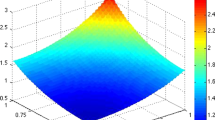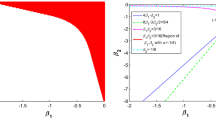Abstract
This paper is concerned with developing accurate and efficient nonstandard discontinuous Galerkin methods for fully nonlinear second order elliptic and parabolic partial differential equations (PDEs) in the case of one spatial dimension. The primary goal of the paper to develop a general framework for constructing high order local discontinuous Galerkin (LDG) methods for approximating viscosity solutions of these fully nonlinear PDEs which are merely continuous functions by definition. In order to capture discontinuities of the first order derivative \(u_x\) of the solution \(u\), two independent functions \(q^-\) and \(q^+\) are introduced to approximate one-sided derivatives of \(u\). Similarly, to capture the discontinuities of the second order derivative \(u_{xx}\), four independent functions \(p^{- -}, p^{- +}, p^{+ -}\), and \(p^{+ +}\) are used to approximate one-sided derivatives of \(q^-\) and \(q^+\). The proposed LDG framework, which is based on a nonstandard mixed formulation of the underlying PDE, embeds a given fully nonlinear problem into a mostly linear system of equations where the given nonlinear differential operator must be replaced by a numerical operator which allows multiple value inputs of the first and second order derivatives \(u_x\) and \(u_{xx}\). An easy to verify set of criteria for constructing “good” numerical operators is also proposed. It consists of consistency and generalized monotonicity. To ensure such a generalized monotonicity property, the crux of the construction is to introduce the numerical moment in the numerical operator, which plays a critical role in the proposed LDG framework. The generalized monotonicity gives the LDG methods the ability to select the viscosity solution among all possible solutions. The proposed framework extends a companion finite difference framework developed by Feng and Lewis (J Comp Appl Math 254:81–98, 2013) and allows for the approximation of fully nonlinear PDEs using high order polynomials and non-uniform meshes. Numerical experiments are also presented to demonstrate the accuracy, efficiency and utility of the proposed LDG methods.















Similar content being viewed by others
References
Arnold, D., Brezzi, F., Cockburn, B., Marini, D.: Unified analysis of discontinuous Galerkin methods for elliptic problems. SIAM J. Numer. Anal. 39, 1749–1779 (2001)
Bardi, M., Capuzzo-Dolcetta, I.: Optimal Control and Viscosity Solutions of Hamilton-Jacobi-Bellman Equations, Systems & Control: Foundations & Applications. Birkhäuser Boston Inc., Boston, MA (1997)
Barles, G., Souganidis, P.E.: Convergence of approximation schemes for fully nonlinear second order equations. Asymptot. Anal. 4(3), 271–283 (1991)
Caffarelli L.A., Cabré X.: Fully Nonlinear Elliptic Equations, Vol. 43 of American Mathematical Society Colloquium Publications. American Mathematical Society, Providence, RI, (1995)
Caffarelli, L.A., Souganidis, P.A.: A rate of convergence for monotone finite difference approximations to fully nonlinear, uniformly elliptic PDEs. Comm. Pure Appl. Math. 61, 1–17 (2008)
Cockburn, B., Shu, C.-W.: The local discontinuous Galerkin method for time-dependent convection-diffusion systems. SIAM J. Numer. Anal. 35, 2440–2463 (1998)
Crandall, M.G., Lions, P.-L.: Viscosity solutions of Hamilton–Jacobi equations. Trans. Am. Math. Soc. 277(1), 1–42 (1983)
Crandall, M.G., Lions, P.L.: Two approximations of solutions of Hamilton–Jacobi equations. Math. Comp. 43, 1–19 (1984)
Feng, X., Neilan, M.: The Vanishing Moment Method for Fully Nonlinear Second Order Partial Differential Equations: Formulation, Theory, and Numerical, Snalysis. arxiv.org/abs/1109.1183v2
Feng, X., Neilan, M.: Vanishing moment method and moment solutions for second order fully nonlinear partial differential equations. J. Sci. Comput. 38, 74–98 (2008)
Feng, X., Glowinski, R., Neilan, M.: Recent developments in numerical methods for second order fully nonlinear PDEs. SIAM Rev. 55(2), 205–267 (2013)
Feng, X., Kao, C., Lewis, T.: Convergent finite difference methods for one-dimensional fully nonlinear second order partial differential equations. J. Comp. Appl. Math. 254, 81–98 (2013). doi:10.1016/j.cam.2013.02.001
Gilbarg, D., Trudinger, N.S.: Elliptic Partial Differential Equations of Second Order, Classics in Mathematics (reprint of the 1998 edition). Springer, Berlin (2001)
Krylov, N.V.: The rate of convergence of finite-difference approximations for Bellman equations with Lipschitz coefficients. Appl. Math. Optim. 52(3), 365–399 (2005)
Kuo, H.J., Trudinger, N.S.: Discrete methods for fully nonlinear elliptic equations. SIAM J. Numer. Anal. 29(1), 123–135 (1992)
Lewis, T., Feng, X.: Mixed interior penalty discontinuous Galerkin methods for one-dimensional fully nonlinear second order elliptic and parabolic equations. J. Comput. Math. (under review)
Lewis, T., Feng, X.: Nonstandard local discontinuous Galerkin methods for fully nonlinear second order elliptic and parabolic equations in high dimensions. (In preparation)
Lewis, T., Neilan, M.: Convergence analysis of a symmetric dual-wind discontinuous Galerkin method. J. Sci. Comput. (to appear)
Lieberman, G.M.: Second order parabolic differential equations. World Scientific Publishing Co. Inc., River Edge, NJ (1996)
Nitsche, J.A.: Über ein Variationsprinzip zur Lösung von Dirichlet Problemen bei Verwendung von Teilraumen, die keinen Randbedingungen unterworfen sind. Abhandlungen aus dem Mathematischen Seminar der Universität Hamburg 36:9–15 (1970/1971)
Rivière, B.: Discontinuous Galerkin Methods for Solving Elliptic and Parabolic Equations, Vol. 35 of Frontiers in Applied Mathematics. Society for Industrial and Applied Mathematics (SIAM), Philadelphia, PA (2008)
Yan, J., Osher, S.: Direct discontinuous local Galerkin methods for Hamilton–Jacobi equations. J. Comp. Phys. 230, 232–244 (2011)
Author information
Authors and Affiliations
Corresponding author
Additional information
The work of this author was partially supported by the NSF grant DMS-0710831.
Rights and permissions
About this article
Cite this article
Feng, X., Lewis, T. Local Discontinuous Galerkin Methods for One-Dimensional Second Order Fully Nonlinear Elliptic and Parabolic Equations. J Sci Comput 59, 129–157 (2014). https://doi.org/10.1007/s10915-013-9763-3
Received:
Revised:
Accepted:
Published:
Issue Date:
DOI: https://doi.org/10.1007/s10915-013-9763-3




